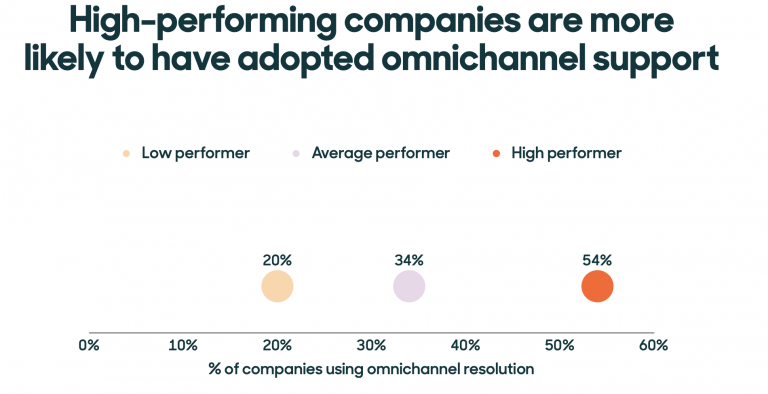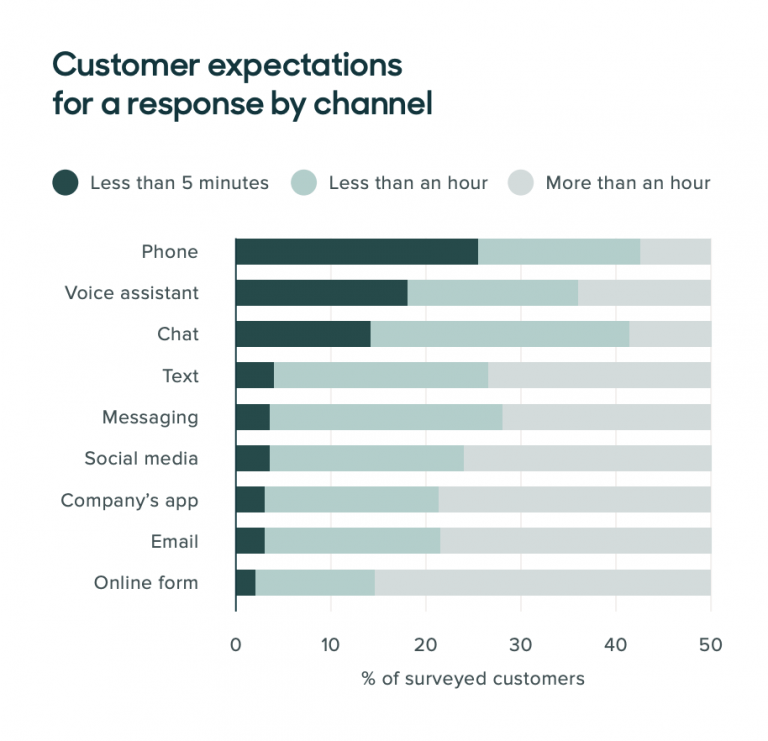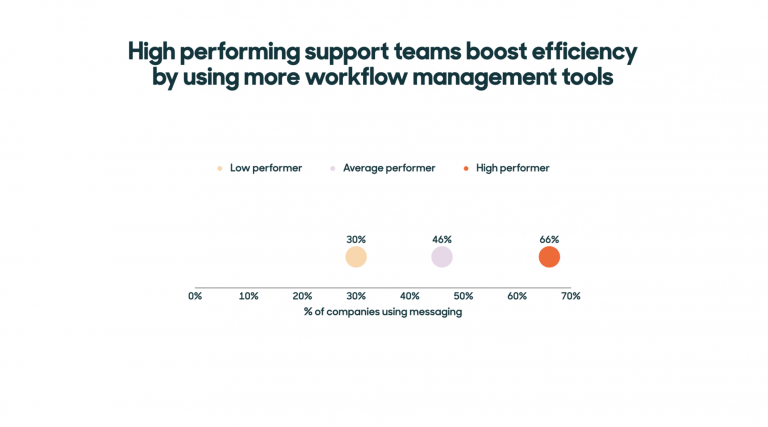When you think about your best customer service experience, what comes to mind?
Maybe it was the barista who knew your name and just how you like your latte. Or that time you called customer support, and the agent sympathized with you, then went out of their way to fix the issue.
An excellent customer experience can change the way customers think about a company. It can also build loyalty.
The keys to great customer service
- Channel choice
- Empathy
- Customer-centricity
- Proactice support
- Personalization
- Speed
- Self-service
- Empowered agents
- Collaboration
- Agility
1. Serve your customers in the channels of their choice
If a customer tweets a complaint, you might be tempted to “take that conversation offline” so it’s not hashed out in public.
But it’s not always that simple. Maybe they’ve already tried calling your toll-free number and had a long wait time. Or maybe they just prefer social media for customer service. People pick channels based on how quickly they want a response, and how complex their problem is.
Customers want to connect with you on the same channels they use to talk to friends and family. So being able to help a customer on their preferred support channel is one of the best ways to create an excellent customer service experience.
Customers want to connect with you on the same channels they use to talk to friends and family
Your agents need to be able to handle questions by phone, email, messaging, live chat, social media and more.
It helps when your technology can track it all and let agents seamlessly switch between communications channels.
For example, suppose a customer starts with live chat, but the issue becomes too complicated for that. In that situation, you want your agents to be able to easily transition to a phone call.
Omnichannel customer service works
High performing customer service teams are more than twice as likely as underperforming ones to have an omnichannel strategy.
Companies that offer omnichannel support:
* Resolve tickets more than three times faster
* Make customers spend 75 percent less time waiting for agents to respond
* Handle significantly more help tickets — 5.7 times as many requests on average

2. Have empathy
You really have to be able to relate to a customer to deliver a great experience. That starts with empathy. It means putting the customer at the center of everything you do.
It’s a crucial customer service skill. And, it means being driven to help them – not seeing them as an annoyance to handle, but as the hero of your story.
“Many organizations raised the bar in terms of their empathy for customers during 2020—from bank loans getting frozen for customers undergoing financial hardship to insurance premiums being drastically reduced because people were in the middle of lockdown and not driving their cars enough, said Motteram. “In 2021, we will see customers expecting companies to continue to be more empathic and flexible than they’ve been in the past. Organizations need to invest in empathy training and empower agents with well-defined delegations that allow them to go outside of policies to deliver satisfactory solutions.”
“In 2021, we will see customers expecting companies to continue to be more empathic and flexible than they’ve been in the past.”
Ben Motteram, Principal and CX Expert
3. Put customers at the center of your orbit
Customer-centric companies are on the rise, and they look for people who are driven to deliver a truly great customer experience.
It’s a profitable strategy: companies with a truly customer-centric culture are 60 percent more profitable compared to companies that aren’t.
Zappos is so devoted to customers that its number one core value is “Deliver WOW through service.” The idea is infused into everything they do:
All new hires – including executive leadership – spend two weeks taking customer calls
There’s no time limit on customer calls – Zappos gives its agents the freedom to chat as long as a customer needs them. The current record for longest customer service call at Zappos stands at 10 hours, 51 minutes, and is a major source of pride for the team.
Customer centricity is a business strategy that puts customers at the center of everything. And it means more than delivering great customer service, although that is critical.
Companies with a customer-centric culture are 60 percent more profitable than companies that aren’t
Businesses that want to be customer centric need to commit to putting people first.
Being customer centric also means hiring with customer focus in mind – staff should see the customer as the hero of the story, not a bother or problem to solve.
Truly customer focused organizations collect customer feedback in every channel, and share that information across the company to help guide business decisions.
Your customer’s experience is just as important (if not more so) than the product or service you’re selling them. Even if your product is top notch, you’re likely to lose customers to competitors if your user experience is poor.
4. Be proactively helpful
When things don’t go as planned, your customer might let you hear about it. And now one customer issue has become two: fixing the original problem and trying to turn an angry customer into a happy one.
Great customer service often means anticipating your customer’s needs before they even have to tell you.
Proactive customer service is what happens when a business takes the initiative to help a customer before the customer contacts them for help. It means trying to resolve problems at the first sign of trouble.
An example of good customer service
Parisian smartfood start-up Feed. delivers nutritious, well-balanced food to its customers.
As the company grew, they found it challenging to keep up with customer requests, which came in mainly via an email ticketing system.
Since implementing Zendesk Chat, Feed. has been able to improve support through proactive chat. By implementing proactive chat triggers, they host more than 100 live chat sessions per day (up from 10-15 per day). Each chat is a sales opportunity — generating over €180,000 in revenue.
“By engaging with customers as they browse the store or read on the blog, we’re able to provide targeted support and solve their problems in real time,” said Aurore Galland, Customer Support Happiness Manager at Feed. “For example, if someone is reading a blog about losing weight, we can point them to our lower-calorie items.”
There are big benefits to delivering proactive customer service:
– You can often head off problems before they start. Instead of waiting for a customer complaint, you’re doing something to help them now. That saves your customer care team time, and it saves your customer a hassle.]
– If you can use customer data to know what their preferences are, an agent can recommend products in real time. That kind of 1:1 service can lead to higher customer loyalty and more upsell opportunities.
5. Personalize the experience
67 percent of customers are willing to pay more for a great experience, according to the Zendesk Customer Experience Trends Report.
In order to truly create a connection, you need to use data to personalize the customer experience. The truth is, most customers today expect a highly tailored experience: they want a company to know who they are, what they’ve purchased in the past, and even what their preferences are. They also expect you to remember all of this information, and they don’t want to have to repeat themselves.
Another example of good customer service
Online clothing retailer Stitch Fix creates a completely individualized experience for everyone, and it starts from the beginning of the customer journey:
– Customers start with a style quiz, answering questions like “How do you feel about shopping?” and “Do you like to try new trends?”
– Based on those answers, serves up images of outfits you can rate based on your style preferences
– Stitch Fix’s in-house team of personal stylists look at user profiles and provide their expert recommendations
This approach is working. “In a time period where the broader apparel and accessories market saw sales decline 80 percent, we delivered $372 million in net revenue,” Stitch Fix Founder and CEO Katrina Lake said in a statement to investors.
67 percent of customers are willing to pay more for a great experience Zendesk Customer Experience Trends Report
The truth is, your customers already expect highly personalized service. And while consumers are often reluctant to share personal information, 83 percent of consumers are willing to give companies their data if they think it will lead to more personalization, according to research by Accenture.
Of course, you need to be careful here – protecting customer data is a top priority. If you share their data without explicit permission, or use it in a way they didn’t intend, you’ll be breaking your customer’s trust. And once broken, trust is hard for brands to regain.
6. Provide quick customer service
Customer expectations are sky high: they want you to respond quickly.
Millennials and Gen Z, in particular, often prefer channels that lend themselves to immediate responses:
Social media
In-app messaging
Social messaging apps
With older generations, it’s no surprise that consumer preference leans toward more traditional methods like phone, email, and in-store interactions. But patience for response times is shortening: 51 percent of respondents expect a response in less than 5 minutes on the phone, and 28 percent expect the same on live chat.

Exceeding expectations means keeping pace with customers. That might mean something like an automated response for messaging or email to say “We got your question and we’re looking into it.” Similarly, it means a prompt return phone call to a customer who leaves a message. If they have to call you twice, it’s already poor service.
Best practices for speedy customer service
Customers want fast service. That much is clear. So how can you meet this expectation? There are some ways to boost your response time and create more satisfied customers:
Invest in agent training. Give your agents a customer service training program that truly sets them up for success. They should know your products well, have access to a robust knowledge base, and be able to handle difficult customer issues.
Improve processes that slow things down. Getting tickets to the right teams as quickly as possible is key. One way to do this is creating a “customer service triage” team to manage each ticket that comes in, especially if you have a lot of complex questions.
Get on the phone. If an agent is having a lot of back and forth with a customer, or there are long delays between replies, find a time to give them a call. Sometimes, this is the quickest way to get to a resolution.
7. Make it easy for customers to help themselves
Customers don’t always want to ask someone for help. So sometimes, excellent customer service means letting people help themselves. 69 percent of customers want to resolve as many problems as possible on their own, and 63 percent always or almost always start with a search on a company’s website.
Sometimes, excellent customer service means letting people help themselves
But there’s a noticeable gap: many companies aren’t taking advantage of this opportunity. Only a third of companies offer a knowledge base or community forum, and less than one in three offer social messaging, chatbots, or in-app messaging.
By building out an easy way for customers to self-help, you’ll relieve pressure on your support team and create happy customers.
Best practices for customer self-service
Create a help center. Track the top issues and customer complaints that come in through tickets. Then, write help center articles based on those questions.
Don’t stop there, though – keep building out your knowledge center to make it easier for customers to find answers on their own.
Consider a chatbot. Customers want to take care of problems themselves, and they’re open to bots and artificial intelligence (AI) if it means fast, efficient resolution to their issues.
Make sure customers can ask for human help. End your FAQs and help center articles with “Did this answer your question?”
If the customer’s response is “No, I still need help,” then it’s time to offer live chat with an agent. They’ve already tried to solve the issue on their own, so it’s time to escalate to the next tier.
Don’t add unnecessary hurdles. When you make customers enter a lot of personal information before they’re able to get help, it’s more likely they’ll abandon it altogether.
Ideally, they can log into their account and be able to access whatever they need without giving you more details, making the process much easier for everyone.
8. Equip agents with tools to work more efficiently
A good customer experience and a good employee experience are like peanut butter and jelly: they’re inextricably linked. So much so, companies with the most engaged employees enjoy 81 percent higher customer satisfaction, experience half the turnover of their peers, and have a decisive competitive advantage, according to a Forrester report.
Supporting your support team means equipping them with the tools and processes they need to do their jobs well. Our Trends Report found that higher-performing teams are making structural changes to workflows that better suit employees’ needs.

Businesses can eliminate friction for agents in addition to customers by:
Arming agents with a unified workspace, so they have customer context at their fingertips and don’t have to toggle between different tools to help your customers.
Improving agents’ workflows by automatically routing customers to the agent with the right skills for the task and providing agents with prepared answers, so they don’t have to type out your reimbursement policy.
Passing on repetitive requests to a bot so agents can focus on the more engaging parts of their job.
9. Empower agents to collaborate
Resolving customers’ issues often requires agents to work with each other and other departments, and customers expect businesses to collaborate on their behalf. In fact, 31 percent more agents said they need tools that enable them to collaborate across teams internally this year compared to last, according to our research.
With tools like Slack and Zoom inside their workspace, agents can collaborate inside and outside the CX organization.
10. Use your analytics to improve
To keep up with customer needs, support teams need analytics software that gives them instant access to customer insights across channels in one place. This enables them to be agile because they can go beyond capturing data and focus on understanding and reacting to it, instead. Yet 40 percent of managers don’t have the right analytics tools to measure success for remote teams, according to our Trends Report.
With real-time and historical analytics built inside their CX solution, support leaders can take action on what’s happening at the moment and understand past trends. They can identify areas of development for their team and learn how customers interact with them so they can improve the overall experience.
Skills for good customer service
Here are the top customer service skills representatives need to provide good customer service.
Empathy, our Trends Report revealed that 49 percent of customers want agents to be empathetic
The ability to identify customer needs
Listening and effective questioning
Clearly and concisely presenting options and solutions
Anticipating customer needs
Listening to customer feedback and acting on what they tell you
Resolving issues with speed and efficiency
Relationship building, something as simple as addressing a customer by their name or following up on a previous issue can go a long way
Being a cross-functional collaborator, resolving customers’ issues often requires working with other agents or departments
Customer appreciation, customers want to feel valued when they reach support
The 7 qualities of good customer service
Most customers have a set of seven basic needs when they interact with an organization, according to Motteram.
Friendliness: The most basic customer need that’s associated with things like courtesy and politeness.
Empathy: Customers need to know the organization understands and appreciates their needs and circumstances.
Fairness: Customers must feel like they’re getting adequate attention and fair and reasonable answers.
Control: Customers want to feel like they have an influence on the outcome.
Alternatives: Customers want choice and flexibility from customer service; they want to know there is a range of options available to satisfy them.
Information: Customers want to know about products and services in a pertinent and time-sensitive manner; too much information and selling can be off-putting for them.
Time: Customers’ time is valuable, and organizations need to treat it as such. For example, putting customer context at agents’ fingertips, so customers don’t have to wait on hold while the agent looks up the details.
Contact Us: Demeter ICT Company Limited, No.1 Zendesk Authorized Solution Provider in Thailand and APAC No.1 Zendesk Authorized Solution Provider in Thailand and APAC. [ Demeter ICT ] – Our specializations are “CX Design”, “Consulting,” “Implementation“, “System Integration” and “Training” for Zendesk. We help clients analyse, design workflows, and build a good CX.
LINE OFFICIAL

-
For additional information and special promotion call now!
Tel. (+66) 2 030 0066 (TH/EN)
Tel. (+86) 14778852841 (CH) - Facebook Page : @demeterapac
- support@dmit.co.th






